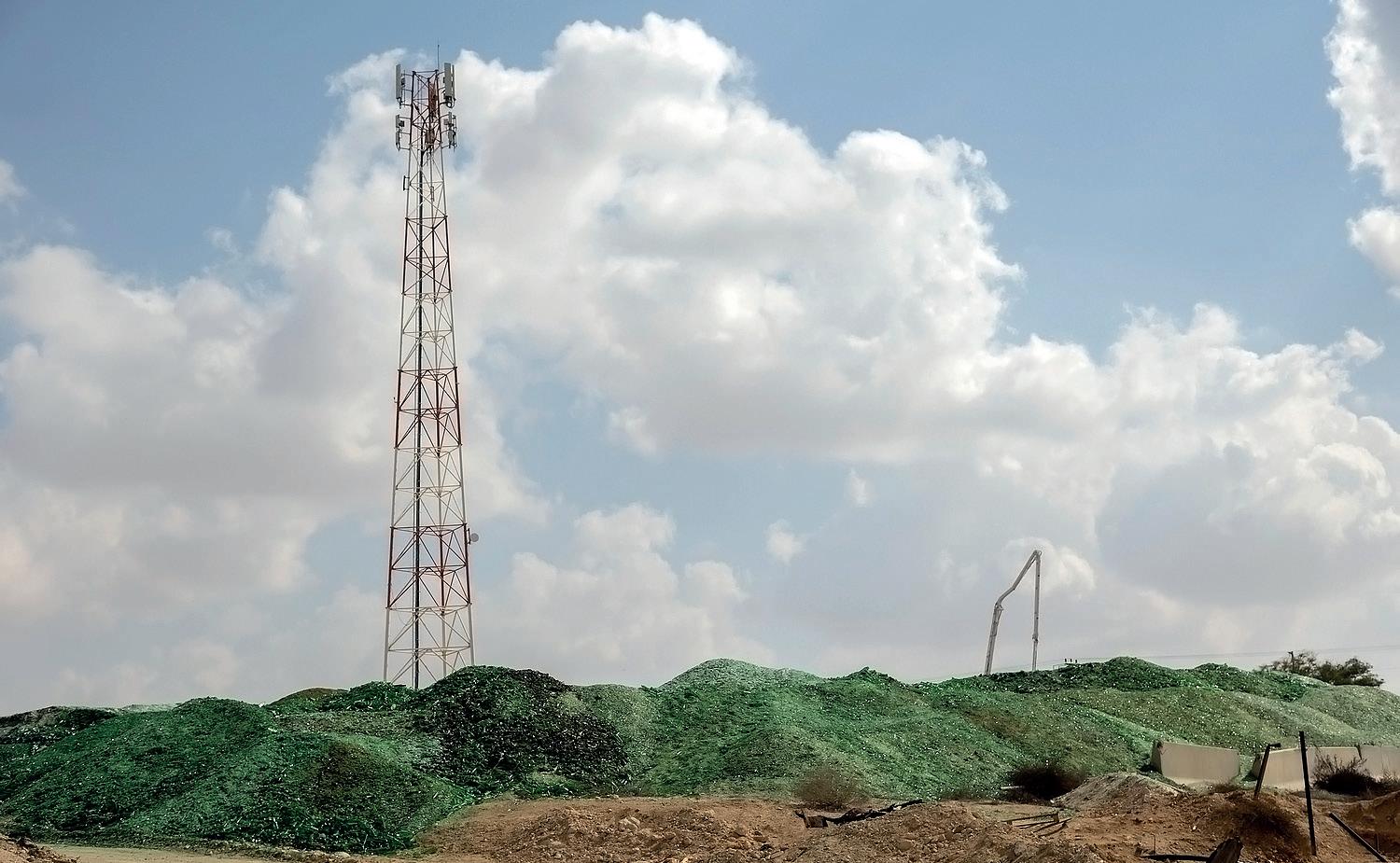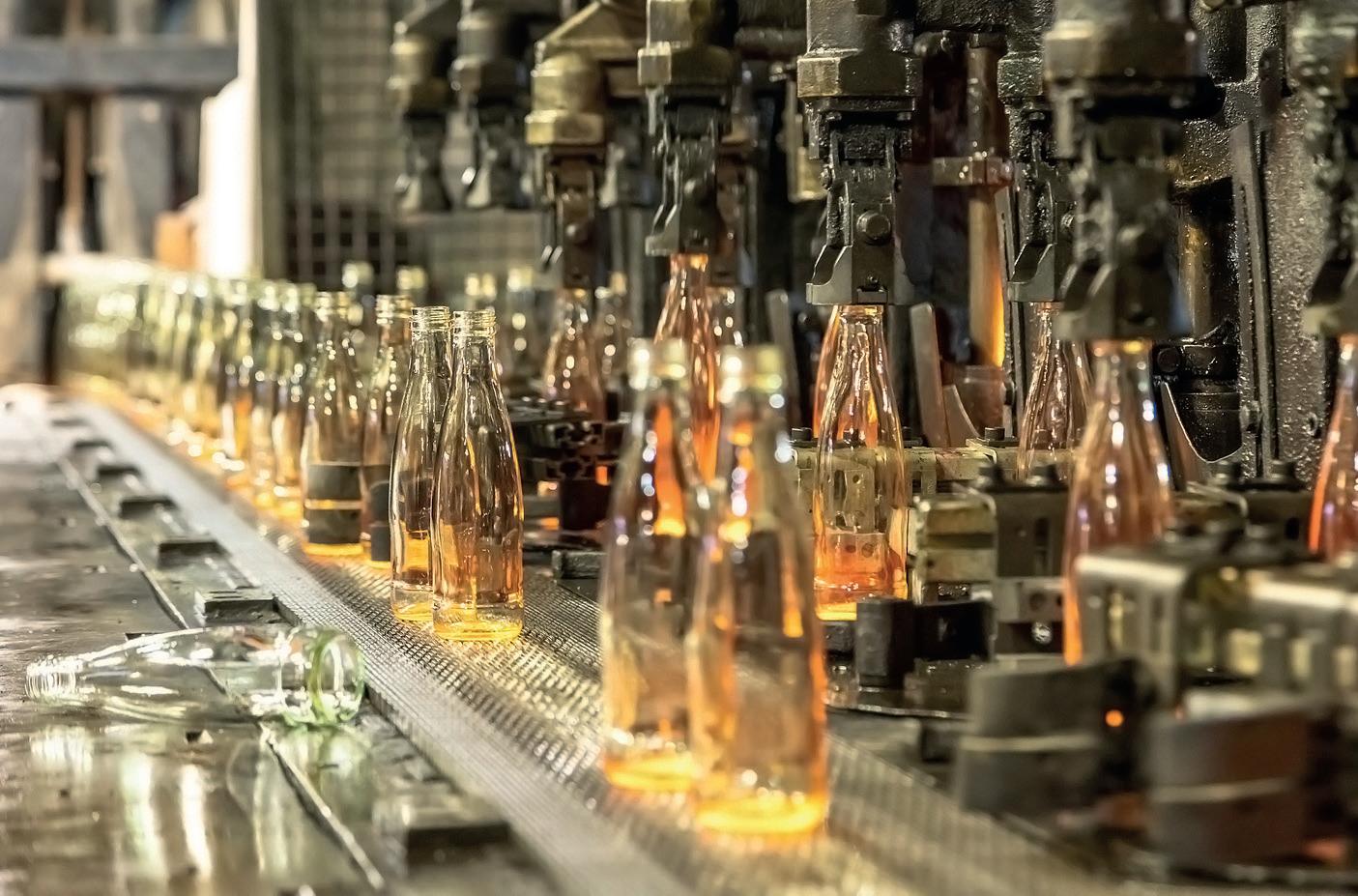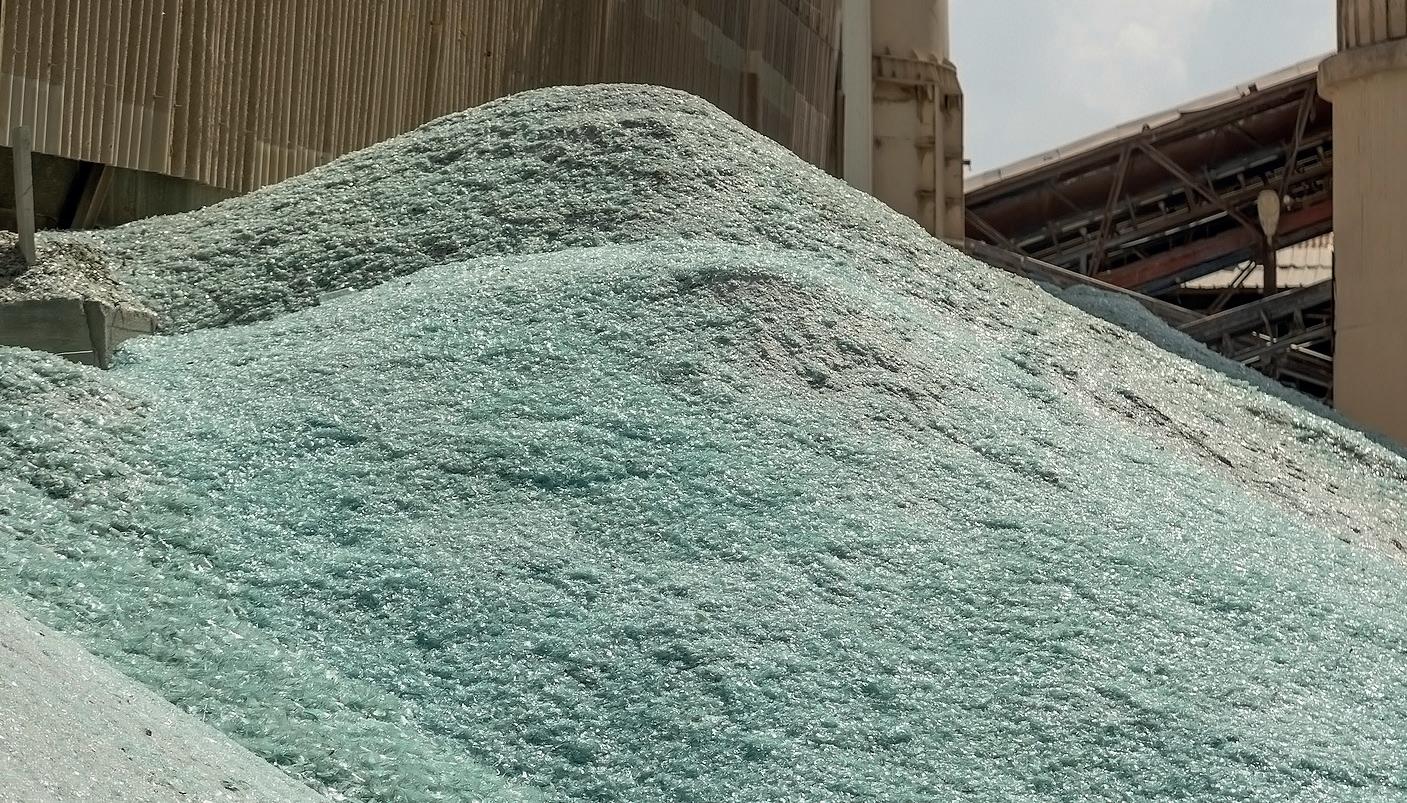
13 minute read
Raw materials: Airovation
Pic 1 (above). From left to right: Gil Tomer, Co-Founder & COO at Airovation Technologies; Mayor Tal Ohana; Phoenicia CEO Michel Ben Simon; and Phoenicia CFO Avi Peer. [Yoav Weiss]
A carbon neutral solution for the glass industry
Airovation Technologies will enable Israeli glass manufacturer Phoenicia to become carbon neutral by converting its CO2 emissions into soda ash. As well as helping the manufacturer decarbonise, it can help prevent supply chain issues. Gil Tomer* discusses the project.
Airovation Technologies is a company based in Israel that provides solutions for air purification and carbon capture.
Phoenicia signed an agreement with the company (Pic 1) to install a unit that transforms CO2 emissions from its Yeruham plant into minerals that can be used in the glass production process.
Following over a decade of research at the Hebrew University of Jerusalem, Airovation has developed a method to capture sodium carbonate (soda ash) from CO2 at the point where the latter is emitted.
Soda ash is a key component of glassmaking. Extracting it from CO2 is done by a patented chemical invention that uses Superoxide Radical, a powerful oxidiser.
Under the new partnership, Airovation will run a three-phase scale-up process, eventually leading to the first fully commercial unit at the Yeruham plant in 2025.
This will reduce Phoenicia’s global warming carbon emissions, contribute to a circular economy, and reduce the company’s dependence on soda ash imports.
How it started
Airovation Technologies originated from Hebrew University, from the team that was working in the Casali Institute of Applied Chemistry in the Hebrew University of Jerusalem. Professor Yoel Sasson led the team.
From the beginning, Professor Sasson has led the chemical research team, along with Doctor Uri Stoin, one of our inventors and the Chief Chemist. We have focused on his research on air decontamination. They are still working with us to commercialise the solution.
Our CEO, Marat Maayan, founded the company in 2013. He had this vision of saving people’s lives in cases of fires in high rise buildings. That is how the company started. He was completely emergency oriented, that was part of his expertise and responsibility in the Israeli Defence Forces (IDF).
He focused on mitigating the risks that were related to bomb attacks and fires. So, he took his experience and know-how to the civil life after retiring from the army, and that’s how he started Airovation.
I joined Airovation in 2017 as a CoFounder. I started as an investor at first, but soon became close with Marat. So, I joined the company a couple of months later in early 2018.
My ambition to invest in Airovation, and later join the company, was because of the technology that I saw coming from the Hebrew University, which was nurtured by Marat’s team.
We found that it could be a relevant and a breakthrough solution, disrupting even, for some industrial use cases. So we shifted the company’s focus from an emergency orientation to an industrial emission orientation.
In 2018, we experimented for two weeks in Chicago at the Underwriters Laboratory (UL), [1] in the UL certification entity. The UL is an independent, nonprofit organisation that tests and certifies components and products for safety; the UL Certification Marks serve as a recognised symbol of trust in customers’ products. With them, we designated an area with furniture that was burned repeatedly.

Mountains of glass from Phoenicia’s plant in Yeruham, Israel. [Yoav Weiss]
We drew the emissions, from a very dirty and uncontrolled environment, into our systems to see how our reactors and our Superoxide Radical solution - the heart of our patents – treated the different emission compositions and the different concentrations of various gases.
The results were even better than we expected. The Superoxide Radical was mineralising the CO2 in an efficient manner inside our reactor. That was the biggest breakthrough of 2018.
In 2019, we validated another stage by taking the same equipment that went to Chicago and connected it to a plant in Northern Israel, in collaboration with the Israeli Environmental Protection Ministry. [2]
It was a pilot, but the demonstration was built on a batch process rather than the continuous process that you would want to see running in factories. But that also had extremely good results in real data and emissions coming from the field.
Emissions included a combination of NOx, SOx, all sorts of cyanides and of course a high concentration of CO2 as well as some carbon monoxide.
That’s when we understood that we needed to look at the CO2 not as a burden, but as something to focus on.
We started focusing on clean streams of CO2, because we found that with clean streams the minerals were becoming purer and in a grade that could immediately go back to the field for additional use in other industries. Consequently, the higher the concentration of the CO2 the better for us.
Previously, we looked at those minerals as something that we need to dispose of, because naturally it was carrying some of these toxic substances from the emissions. But the more CO2 meant the less presence of other toxic materials, making the minerals a high enough grade to be used for glass, as well as food, cosmetics and pharmaceuticals.
Partnership
Our partnership with Phoenicia started due to the pandemic.
We wanted to scale up our solution outside of Israel, but it was difficult to create collaborations abroad because of the travel restrictions put in place.
We couldn’t send engineering teams and chemists to the other parts of the world to start testing. So, whilst working on our global collaborations, we decided to test the waters in Israel.
We reached out to the Phoenicia plant in Yeruham to ask them what their pain points were, because at this stage in Israel there are no real restrictions about CO2 emissions.
Currently, the carbon tax is only opposed on energy producers. However, it’s not regulated, and the thresholds are unclear. There are only indications that the ministry is about to pull some restrictions – they’re talking about 2027 as the beginning stage.
Between the different factories that we checked in Israel, we discovered that something else took place during Covid – the disruption of the supply chain.
We learned that this was a huge pain point for Phoenicia, and many other plants around the world, as they suffered from a lack of raw materials. It almost got to a stage where Phoenicia had to close its factory because it had no raw materials.
They usually operate with a couple of months of reserves, but the reserves were about to end because the shipment was stuck in the ocean and could not be delivered.
This alerted our imagination. We understood that it’s not just about decarbonising, it’s about closing the entire cycle.
For Phoenicia to be able to manufacture their own soda ash, one of the key raw materials, in its backyard out of its emissions, was a strong incentive for them to say yes.
Phoenicia’s end customers were also willing to pay a higher price, a surplus that would be added to the price of the product, to manufacture a blue or green glass product with this technology.
Phoenicia’s CEO, Michel Ben Simon, is also very motivated. When asked why Phoenicia wanted to invest in this technology, he gave the following three reasons:
� In 2027, we will be asked by the Israeli government to eliminate CO2 emissions by law. The best solution today is to convert the melting furnace to electrical heating (hybrid) as this innovation allows us to use all kinds of fuels without greenhouse pollution.
� The by-product is soda ash material which is one of the major materials in glass composition and the most expensive one.
� To support Israeli start-ups helping to make our plant a better place, and, in the process, support the economy and young visionaries.
In addition, Mr Simon said that Phoenicia was working on a 20,000m2 solar panel expansion on its warehouse, which is now under construction.
The project
We have come to a stage of a continuous process in our laboratories instead of the batch that I mentioned earlier. Now we need to take this continuous process out to the field, and scale it.
Therefore, we have created a three-step scale up plan with Phoenicia.
The first stage of the plan would be to run the equipment that we’ll be deploying in the first quarter of 2023. This will treat more than 1000m3 of flue gas an hour, which is approximately between one to two tonnes of CO2 a day.
The second stage would be between five to 10 times more. Airovation is developing a 40ft container, or modular unit, to treat the CO2. Each unit will be able to treat between 5000 to 10,000 tonnes of CO2 a year. This equates to approximately 5000m3 per hour. This stage is anticipated to be completed by the end of 2023 or early 2024.
Finally, stage three will create a fully operational site by 2025. This will involve chaining eight to 10 of these modular units together to decarbonise Phoenicia’s plant entirely.
Directly, we will be capturing more than 90% of the entire CO2 emissions. However, there are several variants that need to be considered, such as cost of the raw materials and the purity our end users need; the higher the purity, the more energy is needed.
So, there is a trade-off that we have been perfecting for years. We are also developing software to help us optimise the process in all scenarios. But we’ve learned that the higher the conversion rate, the higher the grade of the minerals.
On average, the technology can save up to two tonnes per tonne of CO2 captured, meaning a good life cycle analysis.
Another advantage is distributing the minerals locally. Phoenicia said that if the material was of high quality and the right granulation, then it would not need to import soda ash at all.
If the minerals do not have to be imported from overseas, then the shipping costs can be reduced. As a result, the end price can be competitive for end users of these minerals.
However, we will also try to maintain some flexibility to mitigate the risks that are connected to overwhelming a specific market.
It’s important to mention that this is not the only site in the world that we’re working on. This is not the only hard to abate industry we’re targeting.
We have close ties with a few hydrogen manufacturers as well as the other stakeholders in the supply chain and the value chain of hydrogen.
We’re strong believers that hydrogen is tomorrow’s solution for the ever increasing energy needs of humanity. With our solution, CO2 is captured from steam methane reforming (SMR) processes to create blue hydrogen. We believe that green hydrogen will be the final play, but this will take decades.
Other industries include cement, steel manufacturing, and some chemical processes as well in chemical manufacturing. All of those are signifi cant industries with a substantial carbon footprint.
Therefore, we don’t see ourselves as mineral manufacturers. Our mission is to decarbonise the hard-to-abate industries in the many different ways that we are developing.
The carbon, the minerals and the Superoxide Radical utilisation - that’s just the first step.

Pic 2. Glass bottles on a production line at Phoenicia’s Yeruham plant. [Yoav Weiss]
Glass
The soda ash created with this method has no effect on the grade of the glass. That was one of the crucial points that we checked before starting.
The annual capacity of the Yeruham plant is approximately 100,000 tons of melted glass, which would remain the same once the new units were installed.
The installation of the units would also not have any impact on the production of glass bottles and jars (Pic 2), as the units would be directly connected to the chimney.
For decarbonisation, we’re also counting on the fact that most of the factories that we are in discussions with now, both for container and flat glass, use recycled glass (Pic 3).
This will lower the amount of the CO2 needed in the process and that are emitted from the process, which will help us decarbonise a factory entirely.
We don’t want to put too much of a logistic burden on the input materials and the output minerals. There is a range where we would prefer to work, and the recycling of the glass helps us be in the range, even within larger sites.
Therefore, we’re manufacturing exactly the level of the sodium that’s needed for the process. Consequently, we won’t affect the colour, nor the quality of the glass whatsoever.

Pic 3. Glass cullet at Phoenicia’s plant [Yoav Weiss].
Decarbonisation
I really do not believe that there is just one solution to decarbonise. There is no magic wand. I think there are now 1200 glass container production sites in the world, and even more fl at glass manufacturers - it’s too much for one solution.
We know that there is a limit to the volume that we can capture per site. We won’t be the only option for a large site, but we can be one of the few solutions in the toolbox, which is a common approach now in the decarbonising world.
But for small to medium sites, our solution can stand-alone. However, we want to decentralise our modular units to not overwhelm the mineral market in a specific region. So, we intend to deploy a lot of units in different regions of the world.
This is why we are working on building alliances and strategic partnerships. With a headcount of 35 people, there is only so much we can do at this stage. We never intended to decarbonise the industry by ourselves.
So, we will build consortiums in different regions with EPC companies that can build a plant within a plant so it can house our units properly.
We are now working in three different continents - the US, Europe, and Asia - to build alliances. This is to prepare the infrastructure that’s needed to offer hardto-abate industries a full, one-stop-shop solution, in which they don’t have to worry about the logistic burden nor the maintenance.
The consortiums will be taking care of the entire chain, and will charge by the tonne of CO2 that we are saving by capturing it. This is the first in a number of business mechanisms that we are forming.
Therefore, we will have two income sources. One being the CO2 captured, and the other the minerals. The minerals alone justify the entire operating costs, and even part of the capital expenses. So, in portions, it will make its own return on investment (ROI).
In both ways, companies will generate some revenue from the fact that this equipment and this solution is being deployed in their backyard, so this will be a mutually benefi cial partnership.
It is about global collaborations. Each and every party needs to bring its own speciality and its own capabilities to the table in order to make an impact.
That’s what I found when running this journey of decarbonising and treating industrial emissions in the world, it’s all about working together.
*COO & Co-Founder, Airovation Technologies, Ness Ziona, Israel https://www.airovation-tech.com/
All photo credit to: Yoav Weiss.
References
1. https://www.ul.com/
2.https://www.gov.il/he/departments/ ministry_of_environmental_protection/ govil-landing-page










